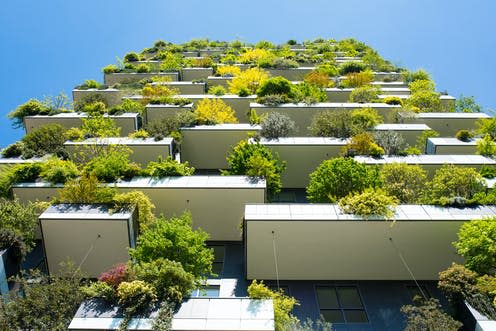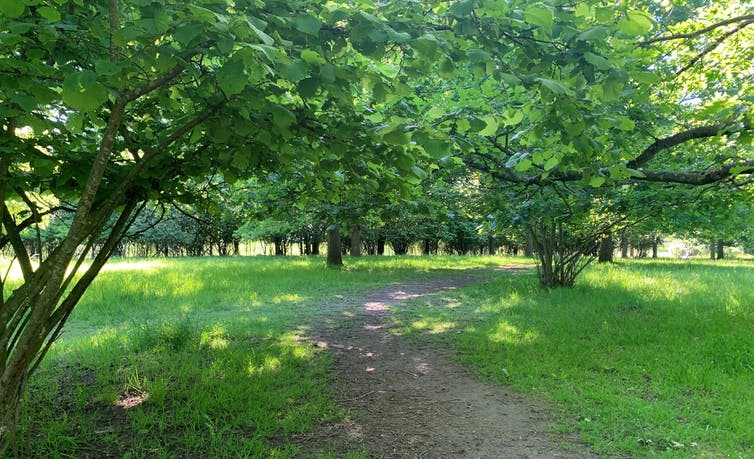Slow down and embrace nature – how to create better cities when the pandemic is over

Throughout the past year of working from home, I have gone for numerous morning, lunchtime and evening walks around my neighbourhood in the Eastern parts of Lund in Sweden. My neighbourhood has three dams for storing stormwater in the event of extreme rain. These help slow the water instead of overburdening the city’s underground water sewage system, which would increase the risk of flooding.
It was at one of these stormwater dams where I first made friends with a beautiful and majestic heron. Like other birds, the heron seems to have found its home here – and it moves between the three dams depending on the time of the day.
I once saw the heron catching a fish, like a better version of one of these TV shows about nature. This vivid image of the heron with the fish has stuck with me – maybe because I observed it directly with my own eyes.
Read more: How to maintain a slower pace of life after lockdown
I find myself returning to the image of the fish-catching heron and pondering on the fact that this bird and I depend on the same ecosystem. The heron for habitat and food, I for recreational purposes (like my pandemic-induced walks) and being saved from flooding. We are so separate, and yet connected.
Multifunctional spaces
These dams aren’t just a water management solution. When it’s cold, they freeze over and provide ice-skating facilities. As well as looking visually striking, they also provide ecosystems and a habitat for animals and wildlife to thrive in.
This kind of multifunctional infrastructure is becoming increasingly popular, with many cities adopting so-called “nature-based solutions” to not just solve environmental problems and safeguard biodiversity, but to also provide local people with recreation space.
In the Naturvation project, which looks at the potential of nature-based solutions to transform cities, nearly 1,000 examples from 100 cities have been collected.
One of my favourite examples is Melbourne’s Urban Forest Strategy, developed to adapt the city to climate change and to improve the wellbeing of people living there. The plan has seen the city increase the number of trees and green spaces.
It also involved setting up a database that maps all the trees in the city. Through this database, people have then been able to send e-mails to individual trees, as a way of connecting with and communicating their love for their favourite tree.

Human-nature links
Being aware of nature and its life-supporting functions, including how we as humans relate to it, is important. It helps our societies to function more sustainably and to recognise the symbiotic relationships we have with the plants and animals around us.
But as well as reflecting on and changing our relationships with the natural world we also need to rethink how we use space in a way that positions nature at the centre of things.
This will not only help to ensure that we consider the natural world and people’s wellbeing but it will also mean better access to green and blue spaces – such as parks, forests and meadows but also rivers, lakes, canals, waterfalls and even fountains. Inequality in terms of access to outdoor spaces has been highlighted during the COVID-19 lockdowns – with people having greater appreciation for the role nature can play in terms of mental and physical wellbeing.

A slow new world
In contrast with the highly efficient and accelerated modern world, the pandemic has slowed things down. Many of us now spend less time rushing about, commuting and travelling long distances. Instead, we spend more time at home and in our local neighbourhoods.
This shift has provided an opportunity for deep reflection about who we are and how we relate to nature. Indeed, many people have used this as an opportunity to escape the city and head to the countryside or the coast.
Against this backdrop, nature-based solutions offer promising options for the post-pandemic world. This is because, in terms of urban planning, it is an approach that, when implemented well, materialises nature-culture links, while also responding to some of the challenges around climate change adaptation in urban areas. Ultimately, we must work with nature – not against it – if we are to really move in the right direction.
This article is republished from The Conversation under a Creative Commons license. Read the original article.

Björn Wickenberg’s thesis work has been partially funded via the Swedish Research Council FORMAS (the ‘Nature-based solutions for urban challenges’ project) and the EU financed project ‘Nature-based Urban Innovation’ (NATURVATION).

 Yahoo Finance
Yahoo Finance 
